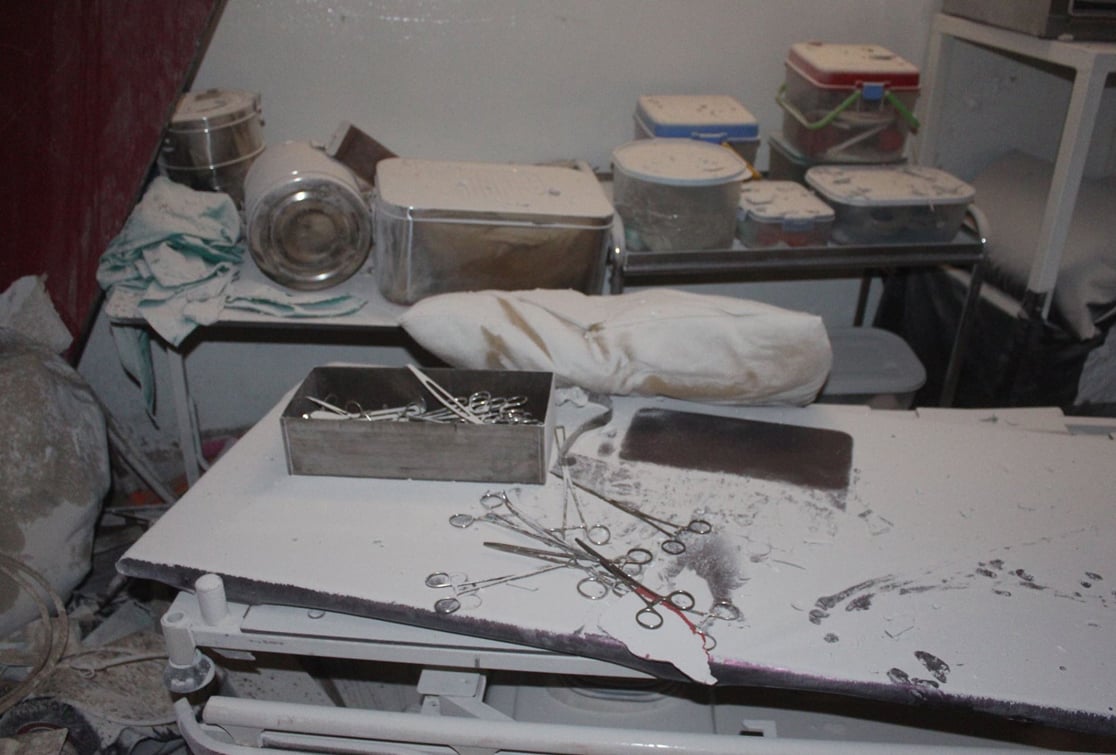A Notable Decrease in Killing and Destruction Rates in Light of the De-Escalation Agreement

SNHR has published its special monthly report that documents the violations against medical and civil defense personnel and their respective facilities by the parties to the conflict in Syria.
The report stresses that Syrian regime forces have been involved, since 2011, in targeting and bombing medical and civil defense facilities as well as the parties to the conflict that targeted medical and civil defense personnel in killing and arrest operations. This indicates a deliberate policy that only aims to kill more and deepen the suffering of the wounded whether they were civilians or armed.
Fadel Abdul Ghany, chairman of SNHR, says:
“The Russian attacks on medical and civil defense centers as well as medical and civil defense personnel are considered a blatant violation of the international humanitarian law and constitute war crimes considering the chaotic, and in many cases, deliberate, targeting of protected objects. All of this have only deepened the suffering of the wounded and injured and is one of the main reasons behind the displacement of the Syrian people as it sends a very clear message: there is no safe area, or a red line, including hospitals, you either flee or perish”
The report highlights the de-escalation agreement in Syria, which commenced on May 6, 2017, after it was announced at the end of the fourth round of Astana talks which was held between representatives from Russia, Turkey, and Iran as the states that sponsored Ankara Ceasefire agreement. The agreement outlined four major de-escalation areas, where a cessation of combat operations will take place in these areas, humanitarian aids will be delivered, and IDPs residents will be allowed a return to these areas. These areas, as specified by the agreement, are: Idlib governorate and the surrounding areas (parts of Aleppo, Hama, and Latakia governorates), northern Homs governorate, Eastern Ghouta, and parts of Daraa and al Quneitra governorates in the southern parts of Syria. It was provided that an expert committee would accurately assign the borders of said zones at a later date.
The report notes that since the agreement went into effect, these areas saw a relatively noticeable and good decrease in killing rates compared with the previous months since March 2011.
The report also notes that May saw an unprecedented drop in the rate of the Syrian-Russian alliance’s violation against medical and civil defense personnel and their respective facilities since the start of the Russian intervention in Syria on September 30, 2015.
The report documents the killing of eight medical, civil defense, and Red Crescent personnel in May 2017 which are divided into two killed by ISIS, one by armed opposition factions, and five by other parties.
The report breaks down the victims, where ISIS killed two civil defense personnel, while armed opposition factions killed one medical personnel. In addition, four civil defense personnel and one Red Crescent personnel were killed by other parties.
Furthermore, the report documents six incidents of attack on vital medical and civil defense facilities including two by Syrian regime forces that targeted two civil defense facilities, while the report records that Russian forces, international coalition forces, and Kurdish Self-Management forces each targeted a vital medical facility. Additionally, the report records one incident of attack on a civil defense facility by other parties.
The report implements a high-level methodology for documentation which relies on survivors and families’ direct accounts in addition to the process of verifying and analyzing pictures, videos, and some medical records. However, the report notes that this documentation doesn’t include all the cases light of the ban and pursuit by Syrian regime forces and some of the other armed groups.
The report notes that Security Council Resolutions 2139 and 2254, which state that indiscriminate attacks must be halted, have been violated in these attacks. Also, the crime of willful killing constitutes a violation of Article 8 of Rome Statute which amounts to war crimes.
Moreover, Syrian forces violated the rules of the international human rights law, committing acts that constitute war crimes. Additionally, Russian forces, armed opposition factions, Self-Management forces, ISIS, and other parties have carried out acts that amount to war crimes through the crime of extrajudicial killing or the targeting of vital civilian facilities.
The report calls on the Security Council to take additional steps as it has been more than two years since Resolution 2139 was adopted with no pledges to cease the indiscriminate bombardment operations being made.
The report emphasizes that the Security Council has to instill peace and security in Syria and implement the norm of “Responsibility to Protect” in order to save the Syrian people’s lives, culture, and arts from being destroyed, looted, and ruined. Also, sanctions must be expanded to include the Russian and Iranian regimes who have been directly involved in perpetrating crimes against humanity and war crimes against the Syrian people.
The report also recommends the implementation of the Responsibility to Protect (ICRtoP) norm after all others political routes were drought out through the Arab League and then Mr. Kofi Annan’s plan. steps under Article 7 of the Rome Statute must be taken and the norm of the Responsibility to Protect, which was established by the United Nations General Assembly, must be implemented as the Security Council is still hindering the protection of civilians in Syria. The report also calls for renewing pressure on the Security Council to refer the Syrian case to the International Criminal Court.
Lastly, the report urges international organizations to send volunteers to work in safe areas where wounded are sent for treatment especially after many death cases were documented where many patients died because of the limited medical resources.


